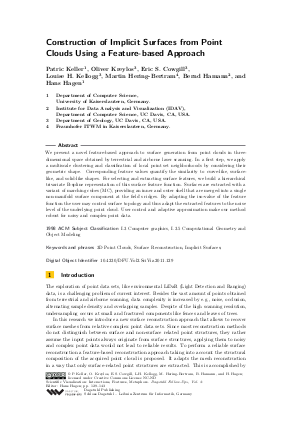Construction of Implicit Surfaces from Point Clouds Using a Feature-based Approach
Authors Patric Keller, Oliver Kreylos, Eric S. Cowgill, Louise H. Kellogg, Martin Hering-Bertram
-
Part of:
Volume:
Scientific Visualization: Interactions, Features, Metaphors (DFU - Vol. 2)
Part of: Series: Dagstuhl Follow-Ups (DFU) - License:
 Creative Commons Attribution-NonCommercial-NoDerivs 3.0 Unported license
Creative Commons Attribution-NonCommercial-NoDerivs 3.0 Unported license
- Publication Date: 2011-10-26
File

PDF
DFU.Vol2.SciViz.2011.129.pdf
- Filesize: 5.25 MB
- 15 pages
Document Identifiers
Subject Classification
Keywords
- 3D Point Clouds
- Surface Reconstruction
- Implicit Surfaces
Metrics
- Access Statistics
-
Total Accesses (updated on a weekly basis)
0Document
0Metadata
Abstract
We present a novel feature-based approach to surface generation from point clouds in three-dimensional space obtained by terrestrial and airborne laser scanning. In a first step, we apply a multiscale clustering and classification of local point set neighborhoods by considering their geometric shape. Corresponding feature values quantify the similarity to curve-like, surface-like, and solid-like shapes. For selecting and extracting surface features, we build a hierarchical trivariate B-spline representation of this surface feature function. Surfaces are extracted with a variant of marching cubes (MC), providing an inner and outer shell that are merged into a single non-manifold surface component at the field’s ridges. By adapting the isovalue of the feature function the user may control surface topology and thus adapt the extracted features to the noise level of the underlying point cloud. User control and adaptive approximation make our method robust for noisy and complex point data.
Cite As Get BibTex
Patric Keller, Oliver Kreylos, Eric S. Cowgill, Louise H. Kellogg, and Martin Hering-Bertram. Construction of Implicit Surfaces from Point Clouds Using a Feature-based Approach. In Scientific Visualization: Interactions, Features, Metaphors. Dagstuhl Follow-Ups, Volume 2, pp. 129-143, Schloss Dagstuhl – Leibniz-Zentrum für Informatik (2011)
https://doi.org/10.4230/DFU.Vol2.SciViz.2011.129
BibTex
@InCollection{keller_et_al:DFU.Vol2.SciViz.2011.129,
author = {Keller, Patric and Kreylos, Oliver and Cowgill, Eric S. and Kellogg, Louise H. and Hering-Bertram, Martin},
title = {{Construction of Implicit Surfaces from Point Clouds Using a Feature-based Approach}},
booktitle = {Scientific Visualization: Interactions, Features, Metaphors},
pages = {129--143},
series = {Dagstuhl Follow-Ups},
ISBN = {978-3-939897-26-2},
ISSN = {1868-8977},
year = {2011},
volume = {2},
editor = {Hagen, Hans},
publisher = {Schloss Dagstuhl -- Leibniz-Zentrum f{\"u}r Informatik},
address = {Dagstuhl, Germany},
URL = {https://drops.dagstuhl.de/entities/document/10.4230/DFU.Vol2.SciViz.2011.129},
URN = {urn:nbn:de:0030-drops-33032},
doi = {10.4230/DFU.Vol2.SciViz.2011.129},
annote = {Keywords: 3D Point Clouds, Surface Reconstruction, Implicit Surfaces}
}
